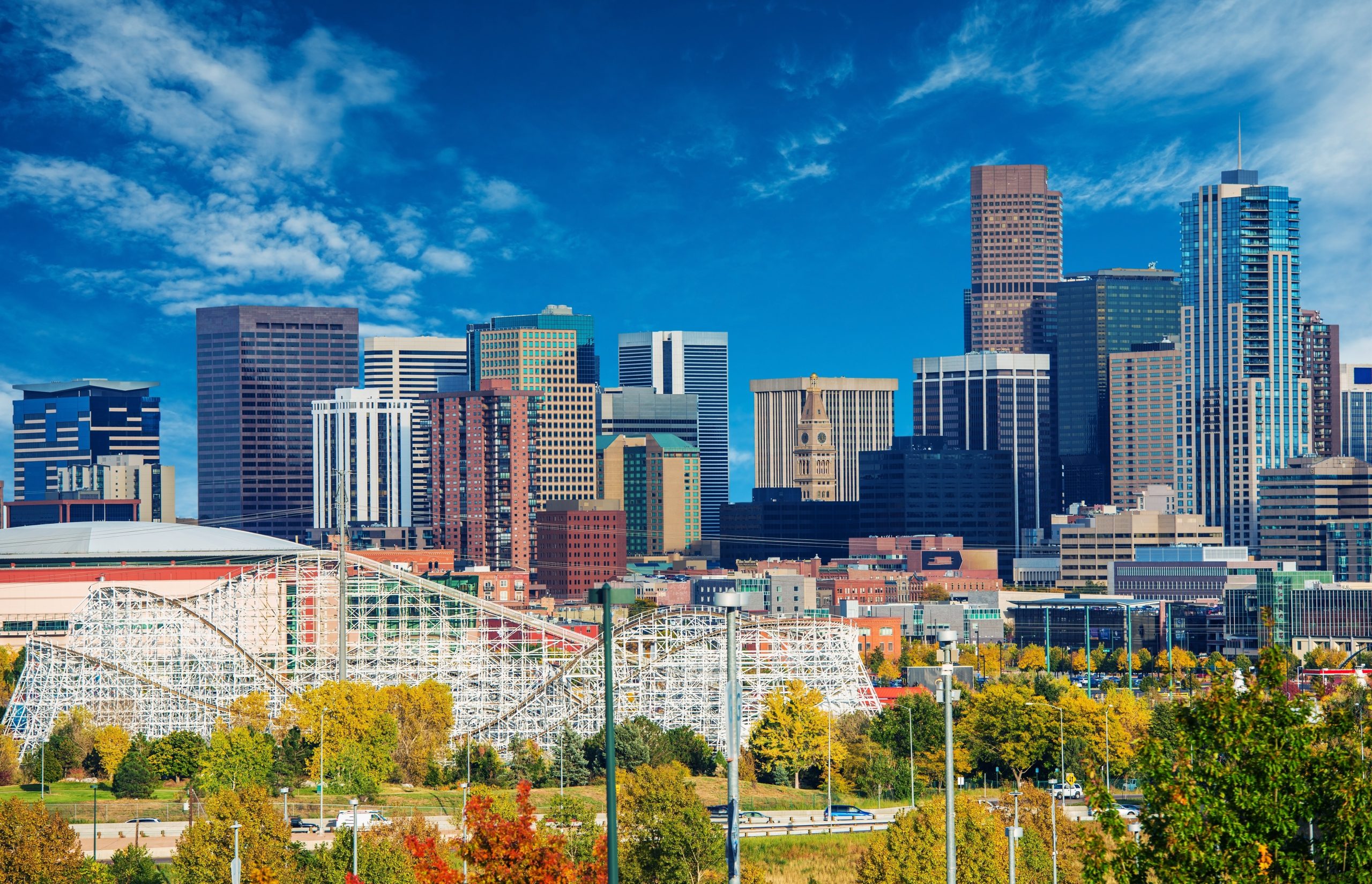
Downtown Denver’s evolving skyline — a city on the rise with major investments reshaping its future.
A Transitional Moment for Savvy Investors
Explore why Downtown Denver is poised for a real estate renaissance, driven by massive revitalization projects, new developments, and long-term investment upside.
Introduction: Downtown’s Transitional Moment
Downtown Denver is in transition. Storefront vacancies and a recent softening in office demand have left parts of the city’s core quieter than they were a few years ago. Safety concerns and pandemic-era disruptions have cast a short-term shadow. Yet these challenges are short-term – and they carry the seeds of long-term opportunity. Just as downtowns in other major cities have rebounded before, Denver’s urban heart is gearing up for a revival. Savvy buyers and investors recognize this transitional moment as a chance to get in on the ground floor. Lower prices and less competition today could mean strong upside tomorrow as downtown bounces back. In fact, early signs of a renaissance are already visible: new developments are underway, big infrastructure projects are nearing completion, and employers continue to add jobs downtown (over 36,000 jobs added in the past four years). The stage is set for a Downtown Denver real estate investment comeback story.
The 16th Street Mall Rebirth: Downtown’s New Heartbeat
Revitalized 16th Street Mall Downtown Denver. Figure: Denver’s iconic 16th Street Mall is undergoing a $150 million revitalization – widening sidewalks, upgrading paving and lighting, adding trees and public art, and curating new retail experiences. The 16th Street Mall has long been the spine of downtown commerce and tourism, and its overhaul is poised to reenergize the entire district. Construction crews have been busy replacing the old patterned paving with modern granite pavers and expanding the pedestrian walkways. New LED street lights, planter boxes, and ample seating are being installed to make the mall safer and more welcoming at all hours. The redesign also introduces more greenery and flexible public spaces for events and outdoor dining. City officials expect substantial completion by late 2025, meaning that in about two years the mall will shine with a completely new look and feel. Portions of the street are already opening in phases – complete with community celebrations and even marching bands heralding the progress. The impact is anticipated to be huge: a smoother, more walkable pedestrian experience will attract foot traffic back to the mall, encourage shoppers into stores, and boost the appeal of downtown residential properties nearby. Real estate values along 16th Street are projected to rise as the mall’s renaissance restores downtown’s reputation as a vibrant, central gathering place.
KSE’s Ball Arena Development: The Next Downtown Icon
Ball Arena Mixed-Use Development Project. Figure: Ball Arena’s vast surface parking lots will be transformed into a dynamic mixed-use neighborhood, in one of Denver’s most ambitious redevelopment projects. Just as the 16th Street Mall is the historic heart of downtown, the area around Ball Arena (formerly Pepsi Center) is poised to become its future focal point. Kroenke Sports & Entertainment (KSE), which owns the arena, has unveiled bold plans to urbanize the sea of parking lots surrounding the venue. In fact, KSE recently submitted a concept plan for the first phase of development around Ball Arena – a significant step toward turning plans into reality. The vision is a 55-acre mixed-use district featuring everything from entertainment venues and restaurants to offices, residences, and park space. Early renderings and descriptions evoke a vibrant live-work-play enclave similar to LA Live in Los Angeles or Chicago’s West Loop, but tailored to Denver’s spirit. Phase 1 will likely focus on infrastructure and a few anchor buildings (rumored to include residential towers and maybe a hotel), setting the stage for the multi-phase build-out. Once complete, the Ball Arena district could host thousands of new residents and workers, with lively plazas and parks connecting it to LoDo and the Auraria campus. The impacts on surrounding property values are expected to be significant: existing condos and townhomes in adjacent neighborhoods (such as Jefferson Park, LoDo, and the Auraria vicinity) stand to benefit from the elimination of vast parking lots in favor of an active neighborhood. This project will not only extend downtown’s footprint westward, but also create a new iconic destination within downtown – one that keeps people in the city core before and after games, concerts, and events. For Denver, it’s a once-in-a-generation chance to reimagine a huge piece of land in the urban core, and for investors, it’s a signal that big players are betting on downtown’s future.
New Residential Buildings and Tower Conversions
New Residential Towers Downtown Denver. Figure: A wave of modern high-rise projects and office-to-residential conversions is refreshing Denver’s skyline and boosting downtown living options. In the midst of these public megaprojects, private developers are also reshaping downtown’s landscape. Several new residential high-rises are under construction or recently completed, adding hundreds of apartments and condos to the market. For example, a 32-story apartment tower at 1900 Lawrence Street is slated to open soon, bringing luxury apartments with high-end amenities to the central business district. Over in Arapahoe Square and RiNo (just adjacent to downtown), cranes dot the sky for new residential mid-rises targeting young professionals who want an urban lifestyle. These projects are injecting new life into parcels that sat empty or underused, effectively turning parking lots into communities.
At the same time, developers are increasingly exploring adaptive reuse of existing buildings – especially older office towers with higher vacancy rates. Downtown Denver has several 1970s–1980s era office high-rises that are now candidates for conversion into residential units. Converting offices to apartments or mixed-use is a trend gaining momentum as companies downsize space and the city encourages more housing downtown. A few notable conversions are already in the works: for instance, plans have been floated to convert portions of the former Wells Fargo Center annex and other aging office buildings into residential units. Such projects not only reduce the glut of office space but also infuse new residents into the urban core, supporting retail and street activity. Even hotels and historic buildings are being repurposed – an old bank or industrial loft can find new life as modern condos while retaining Denver’s architectural character. The benefit of these new buildings and conversions is twofold: increased housing options (from affordable micro-units to upscale penthouses) draw a broader population to live downtown, and a refreshed skyline signals a city that is continually renewing itself. After a lull, downtown living is being positioned once again as a lifestyle upgrade – with walkability, culture, and convenience unmatched in the suburbs.
Why Downtown Will Be a Prime Investment Over the Next 3–5 Years
Downtown Denver real estate is undervalued today relative to its true potential. The combination of temporary challenges – remote work trends, public safety concerns, and a pandemic hangover in retail – have acted like a weight holding down prices on condos, office buildings, and retail spaces in the city center. But that weight is beginning to lift. Over the next 3–5 years, several forces are set to converge and drive a robust downtown revival:
-
Major public investments coming to fruition: The 16th Street Mall renovation, new transit improvements, and public realm upgrades will all reach completion, making downtown more attractive and functional. Infrastructure that feels brand new invariably boosts demand for nearby real estate, as both businesses and residents gravitate to quality.
-
Anchor projects catalyzing growth: The Ball Arena redevelopment (and potentially the adjacent River Mile project on the old Elitch Gardens site) will create essentially a new neighborhood downtown. This isn’t just incremental growth – it’s transformational. As each phase is built, momentum and interest in downtown will accelerate. Property values in and around these projects could see significant appreciation as the vision materializes.
-
Job growth and corporate returns: Denver’s job market remains strong, and many companies that delayed return-to-office plans are now bringing workers back or adopting hybrid models that still value a central hub. Moreover, Denver continues to attract corporate relocations and expansions due to its high quality of life and young talent pool. (Recall that Downtown Denver added 36,000 jobs from 2019 to 2023 – a remarkable growth statistic that underpins future housing demand.) As daily foot traffic increases with workers and business travelers, downtown’s restaurants, shops, and services will see a boost, creating a virtuous cycle of activity.
-
Urban lifestyle preferences: Demographic trends favor walkable, amenity-rich urban neighborhoods – especially among young professionals and downsizing baby boomers. The very cohorts driving housing demand in the coming years are those who value city life. Denver’s downtown offers sports venues, theaters, museums, top-notch dining and nightlife, all within a compact area. As safety and cleanliness improve (a priority for the city, which has recently increased police presence and outreach downtown), many who moved to suburbs for a quieter phase of life may rekindle their interest in the vibrant city core. This could mean a wave of buyers coming back for condos with mountain views and easy access to everything.
-
Limited supply and replacement cost: Building downtown isn’t cheap – the cost of constructing new high-rises is very high, and there are only so many parking lots left to fill in. This means that existing properties (residential or commercial) have a replacement cost advantage. If downtown demand even partially bounces back, prices could rise quickly to levels that justify new construction. Early investors can therefore benefit from the upside as the market normalizes from its current dip.
In short, all the ingredients for a downtown resurgence are mixing together: public and private investment, economic growth, shifting lifestyle trends, and an overall improving outlook. Those who buy or invest now stand to benefit from both asset appreciation and a return of strong rental demand. It’s a classic case of “buy low, then watch it grow.” The next 3–5 years could see downtown Denver real estate returning to prime form, with price per square foot catching up (or even outperforming) other hot neighborhoods.
Final Thoughts: Who Should Be Paying Attention
Vibrant Downtown Denver Streetscape 2025. Figure: Denver’s downtown streetscape is on track to become livelier and more inviting in the coming years – a boon for residents and investors who act early. Not everyone has the foresight or risk tolerance to invest during a transitional period – but those who do could reap substantial rewards. A few groups, in particular, should be watching Downtown Denver closely right now:
-
Young professionals and first-time buyers: For millennials and Gen Z who have dreamed of an urban lifestyle, downtown’s current softness is a chance to buy in at a relative discount. Prices for condos and lofts in the heart of the city are more approachable today than they were a few years ago. These buyers can position themselves not only to enjoy the walkable, amenity-rich lifestyle (imagine walking to ballgames, dinner in Larimer Square, or a short scooter ride to work) but also to see solid equity growth as the area revitalizes.
-
Empty nesters and downsizers: Many suburban homeowners eventually seek the convenience of condo living – no yard work, the city’s culture at your doorstep, lock-and-leave flexibility for travel. Downtown Denver’s renaissance will restore the vibrancy that makes city living exciting. Downsizers who get in now can find great units (maybe that corner loft with mountain views) and customize their urban nest, all while anticipating that their investment will grow. As the downtown theater district, restaurants, and civic events pick back up, they’ll be glad to have front-row seats.
-
Long-term real estate investors: For those building a portfolio, downtown Denver is a strategic play for value-add and appreciation. Rental demand is likely to increase as offices refill and new graduates move to the city. Investors who purchase downtown apartments or retail spaces now, when cap rates are a bit higher, can do well on cash flow and then enjoy the upside of rising rents and property values. The key is to select properties near the “action zones” – like the redeveloped mall or the Ball Arena project – to benefit directly from those improvements.
-
Businesses and entrepreneurs: Finally, it’s not just about housing. Entrepreneurs who believe in Denver’s future can lock in favorable leases for retail or start-up office space downtown right now. By the time the crowds return, those who secured prime locations will have a competitive edge. Similarly, companies looking to recruit top talent should recognize that a downtown address – amidst arts, sports, and nightlife – will once again be a selling point for young employees. Setting up downtown (or buying an office condo) during this window could be a brilliant long-term move.
In conclusion, Downtown Denver is on the cusp of a real estate renaissance. The next few years will be transformative, as cranes fill the skyline and new destinations take shape on the ground. What today might look like a challenge, savvy observers recognize as the opportunity of a decade. If you’ve been considering a downtown move – whether as a homebuyer, investor, or business owner – now is the time to pay attention. The savvy are already strategizing, knowing that in 3–5 years, today’s investments could look incredibly well-timed. Downtown Denver real estate investment isn’t just about buying property; it’s about having a stake in the city’s future success.
Call to action: If you’re curious about what these changes mean for your real estate goals, let’s connect. As a forward-thinking broker deeply familiar with the downtown market, I can help you navigate the options and craft a strategic plan. Whether you’re eyeing a modern condo by the revitalized 16th Street Mall, a commercial space near the Ball Arena redevelopment, or simply want to discuss the trends shaping Denver’s urban core, I’m here as a resource and advisor. Don’t wait for the headlines announcing Downtown’s comeback – by then, the best opportunities may have passed. Reach out today to explore how you can be part of Downtown Denver’s next great chapter. Together, we’ll position you to capitalize on this transitional moment and secure your place in the heart of a thriving, dynamic downtown.

 Facebook
Facebook
 X
X
 Pinterest
Pinterest
 Copy Link
Copy Link




